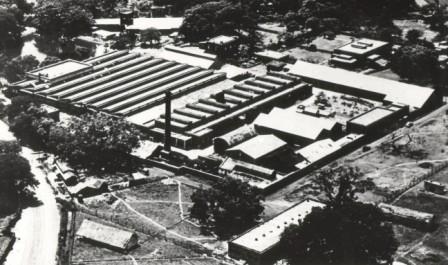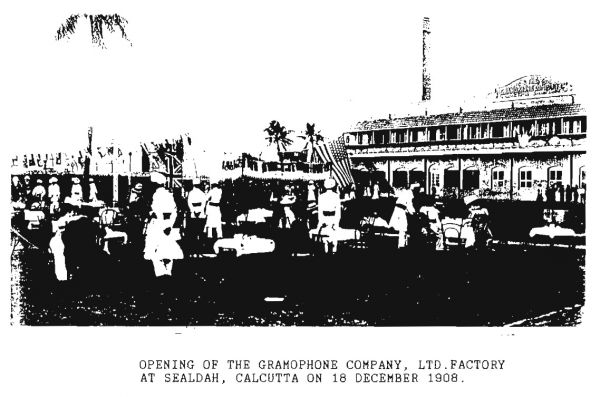The Gramophone Company Ltd., Dum Dum, Calcutta
Nachstehender Artikel geht auf den Beginn der Geschäftstätigkeit sowie die Produktionsstandorte der Gramophone Company in Indien ein.

The Indian operations of the Gramophone Company Limited, London started in 1901 as the first overseas branch. In 1908 the Gramophone Company set up manufacturing facilities one mile east of the commercial centre of Calcutta at 139 Beliaghatta Road, Sealdah, Calcutta.
Within a few years the Sealdah factory was manufacturing discs and assembling machines, not only for India, Burma and Ceylon, but also for the Malay States, Siam, and also Hong Kong and China. By 1921 the Sealdah factory had become very congested and was in need of an overhaul, and so in 1922 the power plant, engine-room and pressing plant were modernised to cope with the increased work-load.

In the ‘acoustic era’ up to 1926, the Sealdah factory was the busiest in Asia, and added a cabinet making house in 1926, on the open area in front of the tank, thus obscuring the original ‘majestic’ profile of the record factory and offices, which included recording rooms (on the first floor), from which emanated the many great recordings that kept the company profitable.
By the advent of ‘electric’ recordings in 1926-27, the Sealdah factory was in need of an extensive overhaul and the decision was taken by The Gramophone Co., Ltd., to build a new and up-to-date factory.
In 1928, the Sealdah factory was closed and building work commenced at the new factory located at 33 Jessore Road, Dum Dum.

Luftbild der 1928 errichteten Fabrikationsanlagen in 33 Jessore Road, Dum Dum
The main building at the Dum Dum site had at one time been the infirmary of the Robert Clive Hospital, and was converted to the main offices of the company. The Dum Dum factory was equipped with the latest disc record pressing machinery and a separate facility for the manufacture of wooden cabinets for gramophones, and commenced operations in May 1929.
Between 1932 and 1944, the associate companies Columbia Graphophone Co., Ltd., and Carl Lindström, A.G. Berlin operated as separate concerns with their own distribution set-up, however, by 1942, the “Odeon” label had been dropped and the administration of the “Columbia” affiliate merged with The Gramophone Co., Ltd.
For a few years before 1947, The Gramophone Co., Ltd., also had a small record factory at Chehharta, near Amritsar in the Punjab, which was known as the ‘Auxiliary works’. Up to 1946, The Gramophone Co., Ltd., in India was owned and controlled by the British parent company (Electric and Musical Industries, Ltd., from 1931) but was converted to an Indian company in 1947, in the name of The Gramophone Company of India, Ltd.
The decision to cease manufacture of 78-rpm records was taken in April 1969, however, 78-rpm records continued to be manufactured up to October 1970 at the Dum Dum factory, when the last entries were made to the catalogues, with many releases being available in alternate 78-rpm and 45-rpm versions, although micro-groove discs had been introduced in the late 1950’s.

Die indischen Aktivitäten der Gramophone Company Ltd., London begannen im Jahre 1901 mit der Schaffung einer ersten Auslandsvertreteung. Die Gramophone Company errichtete 1908 eine Produktionsstätte eine Meile östlich vom kommerziellen Zentrum von Kalkutta (139 Beliaghatta Road, Sealdah).
Innerhalb weniger Jahre expandierte Sealdah und es wurden Platten und Grammophone nicht nur für den Indien, Burma und Ceylon, sondern auch für die malaiischen Staaten, Siam und auch Hong Kong und China produziert. Bis 1921 war Sealdah schließlich derart ausgelastet und musste überholt bzw. erweitert wwerden, sodass 1922 das Kraftwerk, der Maschinenraum und das Presswerk modernisiert wurden um die erhöhten Arbeitsbelastung bewältigen zu können.
In der "akustischen Ära" bis 1926, war Sealdah die größte Fabrik Asiens und errichtete schließlich auf der Freifläche vor dem Gebäude eine neue Schreinerei, sodass die ursprüngliche "majestätische" Gebäudeansicht der Plattenfabrik udn der Büros verdeckt wurde. Das zusätzliche Gebäude erhielt zudem zusätzliche Studioräumlichkeiten (im ersten Stock), aus welchen viele große Aufnahmen hervorgingen, die das Unternehmen lange Zeit profitabel machten.
Durch das Aufkommen der "elektrischen" Aufnahmen in 1926-1927, musste Sealdah modernisiert werden und es wurde seitens der Gramophone Co., Ltd., die Entscheidung getroffen, eine neue und moderne Fabrik zu bauen.
1928 wurde die Fabrik in Sealdah geschlossen und mit den Bauarbeiten an der neuen Fabrik begonnen. Diese befand sich 33 Jessore Road, Dum Dum. Das Hauptgebäude war vormals eine Krankenstation des Robert Clive Hospital gewesen, welches in der Folge zum Hauptbüro des Unternehmens umgebaut wurde. Die Fabrik in Dum Dum wurde mit den neuesten Pressmaschinen für die Plattenherstellung ausgestattet und es entstand zudem eine separate Fabrik zur Herstellung von Holzgehäusen und -schränken für Grammophone. Im Mai 1929 wurde der Betrieb aufgenommen.
Zwischen 1932 und 1944 waren auch die Mitbewerber Columbia Graphophone Co., Ltd., und Carl Lindström AG, Berlin in Indien aktiv und bauten den eigenen Vertrieb auf, obwohl sie bereits seit 1931 zum EMI-Konzern gehörten. 1942 wurde das "Odeon" Label seitens Lindström in Indien aufgegeben und die Verwaltung von Columbia wurde mit jener der Gramophone Co., Ltd. zusammengeführt.
Ein paar Jahre vor 1947 hatte die Gramophone Co., Ltd., auch eine kleine Plattenfabrik in Chehharta, in der Nähe von Amritsar im Punjab. Bis 1946 stand der Besitz der Gramophone Co., Ltd. unter der Kontrolle der britischen Muttergesellschaft EMI (Electric und Musical Industries, Ltd.,). 1947 wurde das Unternehmen zu einem indischen Unternehmen umgewandelt und hieß fortan Gramophone Company of India, Ltd.
1969 wurde die Entscheidung getroffen, keine 78-rpm-Platten mehr herzustellen. Bis 1970 wurden jedoch weiterhin 78-rpm Platten in Dum Dum hergestellt udn diese in den Plattenkatalogen angeboten. Vielen Veröffentlichungen wurden als 78-rpm oder 45-rpm-Version angeboten, obwohl die Langspielplatten bereits in den späten 1950er Jahren eingeführt worden waren.
Der Produktionsstandort in Dum Dum gehört heute dem Rechtsnachfolger der Gramophone Company of India, Ltd., der Saregama India Ltd. und ist im Internet gut zu finden. In google maps ist das Gelände sogar mit "HMV Factory" gekennzeichnet.
WRITTEN BY: The Symbol of Supremacy
SOURCES:
- http://bajakhana.com.au/2015/06/12/bajakhana/
- http://www.musicweb-international.com/Friedman/page19.htm#ixzz3yqYaNngs
- http://static.panoramio.com/photos/original/38619306.jpg
- http://www.mustrad.org.uk/articles/indcent.htm
- dsal.uchicago.edu/books/trn/pdfs/trn_01.pdf
Über Uns
Wir sind mehr als ein Forum! Als eingetragener Verein arbeiten wir an der Beständigkeit unserer Leidenschaft.
Über unsWir suchen Dich!
Du schreibst Artikel, möchtest im Forum als Moderator aktiv werden? Dir liegt Social Media. Bewahre Wissen! Wir warten auf dich.
Schreib unsTipps
Einsteiger-Ratschläge für optimale Nutzung und wichtige Aspekte beim Grammophon und Schellackplatten-Kauf.
Zu den Informationen




